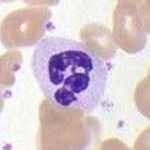Neutrophilia
As neutrophilia refers to an increase in the number of neutrophils (short: neutrophils ) in the blood . Neutrophilia is the most common form of leukocytosis , an increase in the number of white blood cells .
Physiological neutrophilia
Physiological neutrophilia is caused by the release of the hormone adrenaline , for example during fear , joy or heavy physical activity. Adrenaline causes a temporary increase in mature neutrophils for about an hour by releasing neutrophils from storage tissues into the blood.
Glucocorticoid-induced neutrophilia
An increase in the glucocorticoid level can occur through administration as a drug (exogenous), but also endogenously through increased formation in the adrenal gland (for example in Cushing's disease or in stress , pain or trauma ). Glucocorticoids release more mature neutrophils from the stores into the blood and also inhibit the migration of neutrophils from the blood into the tissues.
When exogenous glucocorticoids are administered, the neutrophil count increases within four to eight hours and returns to the initial value after one to three days.
Acute inflammation
Acute inflammation , sepsis , necrosis or immune-mediated diseases lead to an increased need for neutrophils in the foci of inflammation and an increased release from the bone marrow . If the inflammation is more severe, more immature neutrophils are released and there is a shift to the left .
Surgical removal of a focus of inflammation or wound drainage also temporarily increases neutrophil counts.
Chronic inflammation
Some chronic , purulent inflammations (e.g. pyometra , abscesses , pyothorax , pyoderma ) and some neoplasms can lead to an increased formation ( hyperplasia ) of neutrophils in the bone marrow and thus to severe neutrophilia. Here, too, left shift as well as monocytosis and often hyperglobulinemia are common.
A second form of neutrophilia in chronic inflammation occurs when there is a balance between bone marrow production, release and tissue demand. The total leukocyte count and neutrophil count are usually in the upper normal range or only slightly increased, and monocytosis is the most striking change in the white blood count.
anemia
In an anemia due to bleeding or immune-mediated diseases with hemolysis occurs also in an increase in white blood cell count. More mature neutrophils are released about three hours after an acute bleeding.
Chronic granulocytic leukemia
Chronic granulocytic leukemia is usually characterized by distinct neutrophilia with a shift to the left. Increasingly , immature neutrophil precursors ( promyelocytes , myeloblasts ) are encountered.
Congenital neutrophils
A congenital B2 integrin deficiency can occur in some dog breeds (especially Irish Setters ) and leads to reduced adhesion of the neutrophils to the endothelium , reduced chemotaxis and reduced resistance to bacteria . This leads to neutrophilia and frequently recurring infections.
The cyclic hematopoiesis ( gray colic syndrome ) is characterized by cyclical fluctuations in the number of leukocytes in intervals of 10 to 12 days. Here, neutrophilia and neutropenia alternate.

